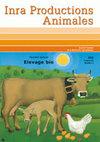Spécialisation territoriale et concentration des productions animales européennes : état des lieux et facteurs explicatifs
IF 0.6
4区 农林科学
Q3 Agricultural and Biological Sciences
引用次数: 20
Abstract
This article aims at analyzing the recent location patterns (since 2000) of animal productions (milk, beef, pork, poultry and eggs) in the Member States of the European Union. The geographical concentration process and the productive specialization of territories are studied from the latest available statistical data at a fine geographical level. The drivers of this process are not new and have already been mentioned in many economists’ publications. They are related to comparative advantages, scale economies and agglomeration economies as well as to the industrial organization of the supply chain. Although the environmental standards (Nitrates Directive, Natura 2000…) and the rural development measures (specific support to farmers in less-favored farming areas) are viewed as a tool to limit or reduce animal concentration, their influence is often weak and not sufficiently strong to counterbalance the above-mentioned agglomeration forces. In addition, we compared the pattern of co-location of different animal production within EU countries and the specialization structure of European regions among countries. For example, the production of granivores (pigs and poultry) tends to be located in the same geographical areas. However, association of dairy cows and pigs is the most common in the most densely populated areas. Beef cattle tend to be located in low animal density areas where other livestock have difficulty eingestablished or maintained.欧洲动物生产的地域专业化和集中度:现状和解释因素
本文旨在分析欧盟成员国动物产品(牛奶、牛肉、猪肉、家禽和鸡蛋)的最近位置模式(自2000年以来)。利用最新的精细地理统计数据,研究了各地区的地理集中过程和生产专业化。这一过程的驱动因素并不新鲜,在许多经济学家的出版物中已经提到过。它们与比较优势、规模经济、集聚经济以及供应链的产业组织有关。虽然环境标准(《硝酸盐指令》,《自然》2000年…》)和农村发展措施(对农业条件较差地区农民的具体支持)被视为限制或减少动物集中的工具,但它们的影响往往很弱,不足以抵消上述集聚力量。此外,我们还比较了欧盟国家内部不同动物生产的共地格局和欧洲地区在各国之间的专业化结构。例如,花岗岩动物(猪和家禽)的生产往往位于同一地理区域。然而,在人口最密集的地区,奶牛和猪的结合是最常见的。肉牛往往位于动物密度低的地区,在那里其他牲畜难以建立或维持。
本文章由计算机程序翻译,如有差异,请以英文原文为准。
求助全文
约1分钟内获得全文
求助全文
来源期刊

Inra Productions Animales
Multiple-
CiteScore
1.30
自引率
33.30%
发文量
0
审稿时长
>36 weeks
期刊介绍:
This journal publishes scientific update reports, results of experiments and their possible applications, analyses on topical issues and presentation of research, information on scientific events and new publications.
INRA Productions Animales deals with all species of zootechnical interest (herbivores, monogastrics and fish), covering feed and nutrition, physiology, pathology, genetics, production techniques, product quality and production economics.
 求助内容:
求助内容: 应助结果提醒方式:
应助结果提醒方式:


